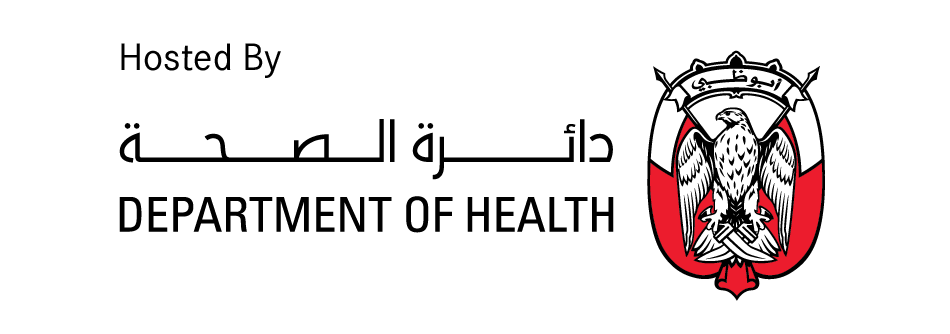THE FORUM @ ADGHW
The Forum @ ADGHW serves as the central element in this global platform for innovation and collaboration uniting government and industry leaders, experts, and academics to tackle pressing healthcare challenges through collaboration, innovation, and investment.

THE FORUM @ ADGHW
At the heart of Abu Dhabi Global Health Week is The Forum @ ADGHW, the flagship conference and cornerstone of the event.
This exclusive conference delivered over 3 days features keynote speeches, panel discussions, and one-on-one conversations from leading minds in healthcare where together, we will address the key questions and decisions to shape a future where we live healthier, happier and longer lives.
ADGHW places a strong emphasis on community-driven health and well-being, with a proactive approach centred around preventive, personalised, and holistic care.
Four core themes will guide discussions and initiatives:
• Longevity and precision health: Personalising the future of medicine
• Health system resilience & sustainability: Crafting future-ready frameworks
• Digital health and AI: Revolutionising care through technology
• Investment in life sciences: Driving global innovation forward

INTRODUCING OUR 2025 FORUM @ ADGHW SPEAKERS
FORUM @ ADGHW: AGENDA
Tuesday 15 April 2025
Wednesday 16 April 2025
Thursday 17 April 2025
09:30 -09:40
In Conversation with H.E. Mansoor Ibrahim Al Mansoori
One-on-one conversation
The Chairman of the Department of Health opens the day with a conversation on how data, innovation, and a personalized approach to public health are shaping a new era of longevity for communities in the UAE and around the world.
09:40 -10:05
Life Sciences Investment: What type of Business Environment Accelerates Investment
Panelists
10:05 -10:15
10:15 -10:50
Collaborating for Impact: Partnerships in Health Innovation
Panelists
Hubertus von Baumbach
Chairman of the Board of Managing Directors and
Chief Executive Officer
Boehringer Ingelheim
10:50 -11:10
Catalysts for Change: Collaborative Giving for Health Equity
Panelists
11:10 -11:30
Unified Procurement Program: A Strategic Leap for Healthcare Sustainability in the UAE
Panelists
H.E. Dr. Amin Hussain Al Amiri
Assistant Undersecretary for the Health Regulation Sector
Ministry of Health and Prevention – UAE (MoHAP)
Bayna Saif Al Awani
Director General of Healthcare Payers and Finance Affairs
Department of Health, Abu Dhabi (DoH)
11:30 -12:00
Rethinking Healthcare Funding
Panelists
12:00 -12:45
Lunch or Network
12:45 -13:45
Opening Ceremony | Health for Humanity: Improving Life for All
Opening Remarks by: H.E Mansoor Ibrahim Al Mansoori, Chairman of Department of Health - Abu Dhabi, UAE
Panelists
13:45 -14:00
Interlude + Interactive Audience Engagement
14:00 -14:30
The New Era of Organ Transplantation
As healthcare rapidly evolves, three key areas are driving the future of longevity and patient outcomes. AI and digital health are revolutionizing diagnosis, treatment, and personalized care, leveraging big data, machine learning, and virtual health solutions to enhance accessibility and efficiency. System resilience and sustainability have become critical in the face of global challenges, with a focus on strengthening healthcare infrastructure, ensuring equitable access, and integrating environmentally sustainable practices. Longevity and precision health are advancing through innovations in genomics, regenerative medicine, and targeted therapies, redefining aging and disease prevention. This opening plenary session will set the scene and explore these pivotal trends, shaping the path toward a healthier and more sustainable future.
Panelists
H.E. Dr. Amin Hussain Al Amiri
Assistant Undersecretary for the Health Regulation Sector
Ministry of Health and Prevention – UAE (MoHAP)
14:30 -14:35
Remarks by Dr. Mark Hyman*
Note: *Pre-recorded video
14:35 -15:00
Breaking the Age Barrier: The Science and Strategy of Longevity
Panelists
Dr. James Kirkland
Director of the Center for Advanced Gerotherapeutics & Professor of Medicine
Cedars-Sinai Medical Center
Prof. Andrea Maier
Oon Chiew Seng Professor in Medicine, National University of Singapore; Co-Founder, NUS Academy for Healthy Longevity, National University of Singapore, Singapore
15:00 -15:25
Scaling Precision Medicine in Longevity
Panelists
Dr. David Barzilai
Founder and CEO, Barzilai Longevity Consulting | Faculty and Trustee, Geneva College of Longevity Science
Healthspan Coaching LLC | agingdoc.com
15:25 -15:55
A Holistic Approach to Community and Health and Longevity. In collaboration with Al Shifaa Summit for Integrative Medicine
Panelists
Dr. Jennifer Stone
Co-Chair Indiana Consortium for Integrative Medicine and Health
Indiana University School of Medicine, USA
15:55 -16:00
Announcement
16:00 -16:10
16:10 -16:35
Exploring the Potential of Targeted Therapies
Panelists
Dr. George Demitri
Institute Physician Senior Vice President for Experimental Therapeutics, Founding Director
Sarcoma Center, USA
16:35 -16:55
Weight-loss Drugs: A Gamechanger for Longevity
Panelists
16:55 -17:00
Announcement
17:00 -17:25
Novel Therapeutic Strategies for Healthy Longevity. In collaboration with Khalifa University
Panelists
Dr. Ayman Al Hendy
Professor, Department of Obstetrics and Gynecology, Pritzker School of Medicine, University of Chicago, and Professor & Chair, Department of Medical Sciences, Khalifa university, Abu Dhabi, UAE
Dr. Barry Merriman
Adjunct Professor of Synthetic Biology, J. Craig Venter Institute; Chief Science Officer & Co-Founder, Avery Bioengineering Inc. & Roswell Molecular Electronics Inc., USA
17:25 -17:55
What’s Next for Gene Editing and Cellular Gene Therapies
Panelists
09:30 -09:35
Remarks by Dr. Tedros Adhanom Ghebreyesus, Director General, WHO*
Note: *Pre-recorded video
09:35 -10:05
21st Century Health Systems
Panelists
H.E. Mansoor Al Mansoori
Member of The Abu Dhabi Executive Council
Chairman of The Department of Health in Abu Dhabi
10:05 -10:35
Health Equity: New Priorities for Impact. In collaboration with Partnership for Health System Sustainability and Resilience (PHSSR)
Panelists
H.E. Prof. Dr. Khaled Abdel-Ghaffar
Deputy Prime Minister for Human Development and Minister of Health & Population
Arab Republic of Egypt
H.E Minister Mikheil Sarjveladze
Minister of Internally Displaced Persons from the Occupied Territories, Health, Labor and Social Affairs of Georgia
10:35 -10:55
Leadership Against Emerging Infectious Threats
Panelists
H.E. Dr. Jean Kaseya
Director General
Africa Centres for Disease Control and Prevention (Africa CDC)
10:55 -11:15
Resilient Health Supply Chains
Panelists
11:15 -11:35
Population Health Innovation for the Next Generation of Care
Panelists
11:35 -11:50
Smart and Sustainable Health Systems
Panelists
11:50 -12:10
The Doctor of the Future
Panelists
11:40 -11:45
Announcement
12:10 -12:35
How Can Technology Improve Equitable Healthcare Access
Panelists
13:00 -14:00
Lunch or Networking
14:10 -14:20
14:20 -14:40
Scaling Excellence: Global Collaboration for Regional Transformation
Panelists
14:40 -15:10
Leading Through Transformation: Hospital CEOs on the Future of Healthcare
Panelists
15:10 -15:15
Announcement
15:15 -15:45
AI-powered Health Support: Transforming Care from Diagnosis to Recovery
Panelists
15:45 -16:10
Unlocking the Potential of Health Data: Trust and Privacy
Panelists
Dr. Christine Yuan Huang
Founder and Chief Executive Officer, Quantum Life | Technology Transfer Director, Hong Kong Quantum AI Lab (HKU,InnoHK)
09:30 -10:00
Top Targets for AI-enabled Drug Discovery
Panelists
10:00 -10:30
AI-enabled Personalized Health Interventions
Panelists
10:30 -10:35
Announcements
10:35 -11:00
The Future of Implants and Brain Computer Interfaces (BCIs)
Panelists
11:00 -11:30
The Future of Data: Novel Sources
Panelists
11:30 -12:00
Connected Health: The Future of Wearables and Home-Based Care
Panelists



































































































































































































































































































